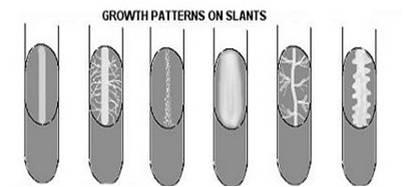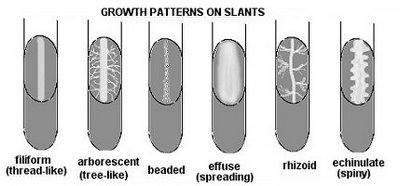MPN
(Most Probable Number) indirect/viable method, live cells. Make statistical estimates numbers of cells by their patterns of growth in liq. culture media
Standard plate count (SPC)
Direct/viable, live cells, good for patients. Dilute a sample in saline, spread on solid media & count colonies. Calculate the # of cells in original sample from counts & dilution. *most common*
Spectroscopy
Indirect/total live & dead, not good for patients. Cells dead & alive. Measure the amount of light that passes thru a liq. culture using a spectrophotometer & est. the # of cells/mL based on amount of light that passes through the culture. * most common *
DAPI or AODC staining & microscopy
Direct/total. Live/dead. Stain the cells w/fluorescent dyes, which make them visible in raw samples (ie soil). Count the # of cells using a fluorescent microscope.
# of colonies needed on media to give accurate counting results
30-300
Spectroscopy method of counting (how it works)
based on turbidity. Optical density used to describe the turbidity of a culture. The Spec 20 can quantify the OD of a culture indirectly by measuring the amount of light that can pass through a a culture (percent transmittance %T). The higher the OD the lower the %T (indirectly proportional, the higher the OD the higher the turbidity (directly proportional)
If you were given a stock culture that was really old, would you expect the SPC to be higher or lower?
Lower because most bacteria in death phase
With SPC/dilution, why bother doing 3 replicates?
To normalize & standardie counts
Why shouldn't you use a plate that has 10 colonies to calulate the number of cells in the starting culture?
Not enough to get statisical validity. NETC
Which counting method would you use if you need isolated colonies from a soil sample and why?
DAPI or AODC staining. You can apply flourescent stain to bacteria you want to to see and use fluoresent microsope.
Kirby-Bauer Technique
Using paper disks impregnated w/different antibacterial medicines on Mueller-Hinton agar plate to determine the sensitivity of a bacterium to serveral antibacterial medicines. No growth or halo around disk = sensitive (zone of inhabition--use whole diameter). Grows right up to the disk = resistant.
Robert Kock
In the 1880s he developed streaking for isolation.
Aseptic technique
Lab technique used to exclude contaminants.
Why is it desirable that microscope objectives be parfocal?
So you can focus it once, then switch objectives and refocus only using fine adjustment knob.
Which objective focuses closest to the slide?
100x Oil immersion
What controls the amount of light reaching the oculars?
Iris diaphragm (opens/closes)and condensor (up/down)
What effect does increased magnification have on the field of vision?
Raise magnification lowers field of view
What does the "ubiquity of microorganisms" refer to ?
The concept that microorganisms are everywhere
Fastidious organisms
Live in body and have "finicky" nutrient requirements
What are the objective powers and names?
4x scanning, 10x low power, 40x high powerh(high dry), 100x oil immersion
Primary purpose of: deeps, slants, broths?
Deeps= ovservie O2 requirements and motility. Slants = surface growth and pattern. Broths = large numbers of bacterial growth.
Resolution (or resolving power)
The ability of lenses to reveal fine detail or 2 points distinctly separated.
When using low-power lense, the iris diaphragm should be...?
Barely open so that good contrast is achieved. More light is needed w/higher magnification.
Darkfield microscopy is valuable for observing...?
Bacterium that are not stainable with conventional stains, but can be observed in directd smears (ex. Treponema pallidum - syphilis).
Brownian movement
Not true motility but rather the movement caused by molecules in the liquid striking an object. Vibrates or quivers.
Shape of most bacteria grown in the lab
Cocci or rods
What is the usual % agar and what is a lower % used for?
1.5% agar is normal. Semisolid deeps 0.5-o.7% agar can be used to determine motility.
Slants vs. plates
Slants also provide a solid growth surface, but are easier to store and transport.

The 6 patterns of growth on agar slants

Arborescent (branched-looks like tree
Beaded
Echinulate (pointed)
Filiform (even)
Rhizoid (rootlike)
Spreading
CFU
Colony forming unit
Where is isolation of bacteria frequently used?
On selective media
Selective Media
Designed to encourage growth of certain types of organisms
Differential Media
Contain indicators that expose differences between organisms (i.e. pH)
Enteric
Gut bacteria, usually Enterobacteriaceae. Coliforms are enteros & lactosefermentators, noncoliform do not ferment lactose
Bacteroides fragilis
The most abudnand bacteria in the human colon. 10^11 cells per gram of feces. Also the most common anerobic pathogen. Used in BBE AGar
Growth patterns in agar & broth
-Colony shape--circular, irregular, punctiform (tiny)
-Margin--entire(smooth, undulate, lobated, filamentous, rhizoid (branched root)
-Elevation--flat, raised, convex, pulvincate (very convex_, umbonate (raised in center)
-Texture--moist, dry, mucoid
-Pigment--opaque, translucent, shiny, dull
-BROTH--pellicles (dots), sediment (at bottom), uniform fine turbidity, flocculent (clump)
Aerotolerance determined in what media?
Agar deep stabs and shakes
Obligate aerobes
Require O2, grow at top
Facultatvie anearobes
Grow with or without O2, grow throughout media but more dense on top
Aerotolerant anaerobes
Don't require O2, but not aversely affected by it. Uniform growth throughout media
Microaerophiles
Survive only in lower than atmospheric levels of O2, middle or upper middle growth in media.
Capnophiles
Are microaerophiles that must have elevated CO2
What type of agar used in agar deep stabs?
Tryptic soy agar
Bile salts
Used in selective media, selects against organisms incapable of surviving gut (especially gram +)
Lactose
Helps distinguish between fermtors and nonfermentors
Thiosulfate
Used to id organisms cable of reducing sulfure to H2S
Ferric Iron
Inicator of sulfur reducers, black precip